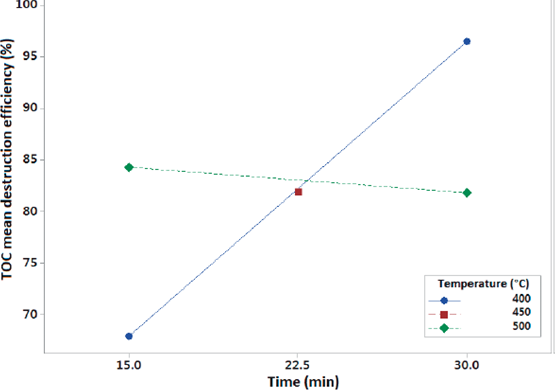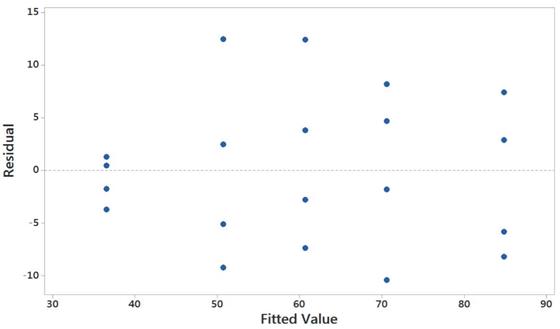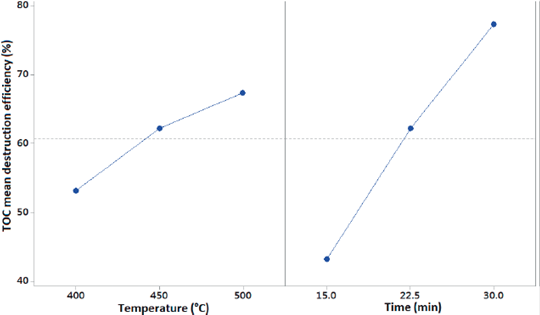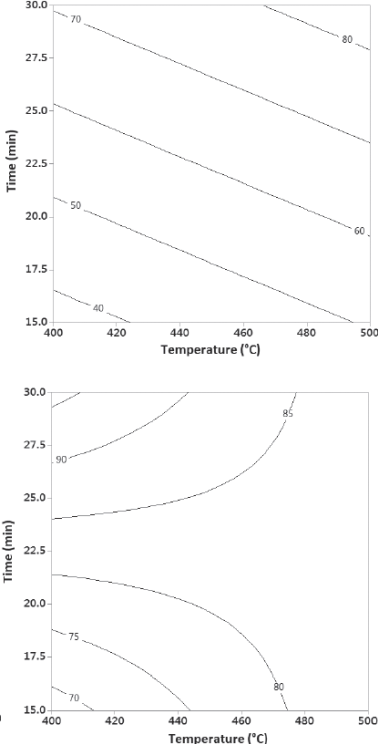Introduction
Municipal solid waste management dumped inappropriately in non-engineered landfill sites generates highly contaminated wastewater called leachate 1. Landfill leachate results from the degradation of the waste organic fraction in combination with percolation of rainwater through solid waste piles 2. Due to different biochemical processes that take place as a result of the stabilization of the organic matter in the waste pile, landfill leachate is heavily contaminated with organic matter and ammonia nitrogen from the ammonification of organic nitrogen, heavy metals and other toxic and priority pollutants. Environmental impacts caused by wastewater of such characteristics, associated with the depletion of oxygen and eutrophication in receiving surface and ground waters, are well documented. Management of landfills could result in several environmental impacts, for example, the percolation of leachates into the groundwater 3. Therefore, an efficient wastewater treatment for landfill leachate must abate not only the organic matter load but also nitrogen and heavy metals, irrespective of the variations in volumetric flow and composition. According to the International Solid Waste Association, a landfill is the "engineered deposit of waste onto or into land in such a way that pollution or harm to the environment is prevented" 4.
In this aspect, landfill leachate treatment continues to be an area of intense research by different physicochemical, biological and emerging methods. However, no single technology claims to handle this heavily polluted residue in an efficient way or compliance with the most stringent regulations without operational constrains that limit in one way or another its practical application. Several authors have extensively reviewed the advantages and drawbacks of conventional as well as emerging leachate treatment process using leachate transfer, biodegradation, physical and chemical methods and membrane processes 2),(5. It is evident from these thorough reviews that the application of the conventional physicochemical and biological treatment technologies to leachate treatment is hindered not only by insufficient chemical oxygen demand (COD) and nitrogen removal efficiencies, but also for operational constraints such as the age of the leachate in the case of anaerobic biological processes, excessive sludge production, ammonia inhibition and energy expenditure in aerobic biological processes, and sludge production and chemicals products consumption in the case of physicochemical processes. With only a few exceptions, COD removal efficiencies varied from poor to moderate, and ammonia nitrogen, recalcitrant compound and considered the rate-limiting step in the total mineralization of organic matter 6),(7, is scarcely addressed. For example, reverse osmosis technology has complemented or replaced conventional landfill leachate treatment. The large volume of concentrate needs to be properly treated. Labiadh et al.8 used anodic oxidation combined with electro-Fenton processes to treat the concentrate and found, under the most favorable electro-Fenton conditions, removal rates of 60 % and 22 % for COD and TN, respectively. Xu et al.9 also used a Fenton process for leachate treatment membrane concentrates and reached 68.9 % TOC reduction. No reference was made to TN or ammonia nitrogen reduction in this study.
Also, and in spite of all of the experimental work reported, it is not possible to make general recommendations regarding the operational conditions and expected performances of conventional processes. For example, hydraulic retention times (HRT) for activated sludge processes, sequencing batch reactors and digesters, vary from a few hours to several weeks for treatment of leachate with similar COD 5. More recently, membranes, especially reverse osmosis (RO), have emerged as an alternative to physicochemical and biological processes. Issues related to fast membrane fouling and the necessary chemical cleaning procedure, which shortens lifetime and decreases the productivity of the membrane, remain as serious drawbacks. A physicochemical process as a pretreatment step before RO could improve the operation while reducing the frequency of membrane cleaning and consumption of chemicals 10.
A great deal of potential impact can be associated with ammonia nitrogen and heavy metals in the environment. Therefore, an all-around leachate treatment process should be assessed not only from the organic matter removal, measured as COD, BOD or TOC reduction, but also ammonia nitrogen and heavy metals abatement. At the same time, it must be done through a single process system, not easily affected by variations in waste chemical composition, nor requiring any additional pretreatment operations, such as pH conditioning or ammonia stripping. Lastly, it should not produce an additional byproduct to be further dealt with, such as biological sludge and gases, as occurs in biological treatment processes 2),(5. All of these criteria could be satisfied by a process known as supercritical water oxidation or SCWO. This is an advanced oxidation process that takes advantage of the fascinating properties of supercritical water as a reaction medium at conditions of temperature and pressure higher than the critical point of water (374 °C and 22.1 MPa) 11. At these conditions, and as a result of the loss of hydrogen bonding, water is completely miscible with organic compounds and oxygen. Therefore, it is possible to carry out rapid oxidation reactions in a single-phase media at very high temperature without mass transfer limitations. Hydrogen peroxide solutions, pure oxygen and compressed and enriched air are used as oxidants in SCWO. Although the required extreme pressure and temperature conditions could impose a high-energy expenditure, SCWO has the potential to be considered a clean energy process 12. The heat released by the oxidation reaction could be converted to heat and shaft work, assuring a self-sustained reaction, as well as generate excess shaft power to drive both the high-pressure pump and the air compressor, as shown by García-Rodríguez 13. Several studies have performed supercritical processes economic assessments through process simulation 14. While these processes require a higher capital investment due to the cost of high-pressure equipment, in the long run, are more profitable due to the possibility of recovering energy from the reactor outlet, cheaper feedstocks and the reduced number of process operations 15),(16.
SCWO has been successfully applied to the treatment of different kinds of persistent and anthropogenic wastes characterized by a high COD and heavy metals concentration. These wastes cannot be efficiently or economically handled by conventional waste treatment technologies such as incineration. Cui et al.17 reported a COD removal rate up to 92 % on oily sludge wastes in less than 10 minutes of reaction time (RT) at 450 °C, 25 MPa, and 427% oxygen excess. Akg et al.18 studied the treatment of textile wastewater by SCWO and reported a decrease in the chemical oxygen demand up to 98.52% in short reaction times, between 4-12 s and temperatures between 400-600 °C at 25 MPa. The difference in reaction times was attributed to the reaction system, being shorter in the continuous one. Du et al.19 reported a continuous flow supercritical water oxidation process to treat high strength COD coking wastewater, which also contained high concentrations of NH3-N, phenol, and inorganic salts. COD destruction close to 99 % at temperature 650°C, a pressure of 25 MPa, reaction time 24 s and 300 % excess oxygen was achieved. Veriansyah et al.20 reported the SCWO of wastewater from liquid crystal display (LCD) manufacturing process, which contains a wide variety of organic pollutants and chromium. A COD conversion greater than 99.99% was obtained at 615°C, 25 MPa, 998 % oxygen excess and 10 s residence time and more than 97% chromium in the wastewater was recovered as chromium oxide. Marulanda and Bolaños 15 studied the SCWO of a heavily PCB-contaminated transformer oil in a continuos process. It was achieved a 99.6 % organic matter conversion and destruction of PCBs under the analytical technique detection limit at 539°C, 24.1 MPa, and 350% oxygen excess. Despite its advantages over conventional end-of-pipe technologies, SCWO has met difficulties at a full scale commercial activity, as reviewed by Marrone 21. Corrosion, plugging, materials durability and out-of-spec feed are the main reasons behind the shutdown of several full-scale plants. New companies continue to enter the field.
Leachate treatment by supercritical water oxidation has been recently reported by several groups using either continuous or batch processes. Gong and Duan 22 studied a landfill leachate treatment process using a continuous system with a transpiring-wall reactor (TWR). In this study, diluted leachate and excess oxidant were fed to the reaction system. COD removal efficiencies were higher than 97 % at 430 C and 30 MPa. Alternatively, Wang et al.23 studied the supercritical water oxidation of landfill leachate with a special focus on ammonia in a batch reactor, at temperatures 380-500°C, reaction time of 50-300 s, oxygen excess (OE) from 100 to 450 % and pressure of 25 MPa, with and without MnO2 as a catalyst. Through a response surface analysis, it was shown that NH3 and COD conversions were low at temperatures near 400 °C and short reaction times. Zou et al.24 studied the co-destruction of organic pollutants in leachates and dioxins in fly ash from leachates incineration using supercritical water oxidation in a batch reactor at different temperatures from 400-500°C, Oxygen excess from stoichiometric to 300 % and residence times of 1 and 2 min. Similar conclusions to those reported by Wang et al.23, with a maximum COD conversion of 99.2 % at 500°C, 300 % OE and 2 min and PCDD/F degradation efficiency >90%, were reported. Nitrogen was not addressed in this study.
A leachate treatment process based on SCWO technology could improve on existing physicochemical and biodegradation processes in aspects such as the organic matter and ammonia-nitrogen conversion, as well as the absence of sludge that needs further treatment 21. In order to assess the feasibility of the scale-up of the process to an industrial level, additional experiments should be conducted to elucidate the effect of the different variables in the leachate treatment by SCWO, in such a way that the lab scale experiments give insights on a possible pilot plant operation. Accordingly, the batch SCWO of landfill leachate with hydrogen peroxide is reported in this work. Process performance is assessed employing a factorial experimental design. Individual factors and its interactions in Total Organic Carbon (TOC) and Total Nitrogen (TN) destruction efficiencies were analyzed.
1. Materials and methods
1.1. Experimental apparatus
SCWO experiments were carried out in a batch reactor made of V2" (1.27 cm) OD Swagelok tubing and fittings, 0.17 cm wall thickness, and 25 cm length for a total reaction volume of 16.98 cm3. The reactor withstands a maximum pressure of 35 MPa at 500 °C. A PID temperature controller oven (± 2°C) was used to carry out the experiments.
1.2. Material and analytical methods
Landfill leachate was collected from a sanitary landfill located in the city of Villavicencio in Colombia, in a WWTP affluent sampling port. HCl to pH 2 was added to preserve the sample and was protected from sunlight and atmospheric oxygen. The sample was kept in a freezer. Hydrogen peroxide (H2O2) 30 wt % solution (Merck) was used as the oxidant. Hydrogen peroxide decomposition in supercritical water produces OH radical, which is extremely reactive. However, it is also very unstable and rapidly decomposes to oxygen 25),(26.
Total organic carbon (TOC) and total nitrogen (TN) were measured before and after SCWO treatment following adapted methods corresponding to standardized methods 5310D for TOC in a DR 3800 Hach Spectrophotometer, and TNb 220 for organically and inorganically bound nitrogen in a Macherey-Nagel nano color Vario 4 Spectrophotometer. Instruments blank were prepared with distilled and deionized water after adding the contents of the ampuls or decomposition reagents required for each method, digested in thermo reactor and set to 0.0 mg/L in both cases. TOC is considered more convenient than BOD or COD due to the presence of organic carbon that does not respond to either of these methods. Total Nitrogen is the sum of nitrate-nitrogen (NO3-N), nitrite-nitrogen (NO2-N), ammonia-nitrogen (NH3-N) and organically bonded nitrogen. Several authors have shown that nitrate and nitrite nitrogen can be formed in SCWO. Therefore, TN is more representative of nitrogen fate in SCW than Total Kjeldahl Nitrogen (TKN), which has into account only ammonia and organic nitrogen.
Total organic carbon and total nitrogen destruction efficiencies were defined according to Equations (1) and (2):
Where TOCi and TNi are the initial concentration of total organic carbon and total nitrogen in the leachate after the dilution with 30 wt% hydrogen peroxide solution and TOCf and TNf are the corresponding concentrations in the reactor effluent.
1.3. Experimental procedure
In a typical batch run, a volume of leachate sample is added to the required volume of 30-wt% hydrogen peroxide solutions to provide the oxygen according to the desired oxygen excess for a specific run. Then an amount of reaction mixture is added to one end of the reactor utilizing volumetric pipettes and sealed with screw caps. The reactor is placed in an electrical insulated clamp-type oven previously heated to the desired reaction temperature, as shown in Fig. 1 and the batch reaction time is set to zero. Once the reaction time is complete, the oven is open and the reactor removed and rapidly quenched in a water bath to stop the reaction.
TOC, TN, and pH were measured in the raw landfill leachate sample as 8700 mg/L, 2800 mg/L and 6.3, respectively. In a typical experimental run, a given amount of undiluted leachate was mixed with a volume of 30 wt% hydrogen peroxide solution, according to the amount of oxidant excess and having into account the reactions for hydrogen peroxide decomposition in SCW 26 and TOC oxidation (Equations 3 and 4):
Accordingly, oxygen excess (OE) was defined as in Equation (5):
Where [O2] is the provided initial concentration of O2 from the decomposition of the added hydrogen peroxide according to the decomposition reaction and [O2] stoich is the calculated stoichiometric amount of O2, according to Equation 4, required to completely oxidize the organic matter measured as TOC, 23200 mg/L of oxygen for 8700 mg/L TOC, which is provided by 49300 mg/L of hydrogen peroxide, 164.3 g/L of 30 wt% hydrogen peroxide solution. Calculated oxidant solution requirement based on this approximation is considerably lower than that resulting from the most widely used COD measurement. The exact mass of leachate-oxidant solution to be injected in the reactor is determined based on the specific volume of water at reaction conditions calculated by means of the Peng-Robinson Equation of State (PR-EOS) and the volume of the reactor. PR EOS has been shown to perform as well as the more complicated perturbed hard sphere Van der Waals equations, with a good qualitative picture of all types of phase behavior and reasonable quantitative representation for a variety of systems 27, 28. The reactor is placed in the oven, previously heated at reaction conditions, and left for a specific reaction time. Once the reaction time is finished, the reactor is removed from the oven and immersed in a cold water bath to stop the reaction. Liquid effluent is collected for TOC and TN analysis. No attempt was made to collect the gaseous phase at this stage of the research.
1.4. Statistical analysis
Experimental runs were planned according to a replicated twice 2k full factorial design with three factors (k): temperature (A), reaction time (B) and oxygen excess (C), using TOC and TN as response variables. Low and high levels of each factor (-1, +1) were selected according to preliminary experiments as well as practical considerations regarding reactor construction materials and hydrogen peroxide consumption. Thus, levels of temperature were 400 and 500 °C, 15 and 30 min reaction time and oxygen excess of 100 and 300 %. With four repetitions in the central point (450 °C, 22.5 min, and 200 % OE), the full design is comprised of 20 experimental runs, made in randomized order. Statistical analysis of the results was made according to the analysis of variance (ANOVA) on both response variables, as well as the graphical analysis of the significant main effects and interactions plots, by using the statistical software package Minitab.
2. Results and discussion
The summary of reaction conditions, initial and final TN and TOC concentrations and destruction efficiencies, is shown in Table 1, in which T is the reaction temperature and Time is the total reaction time. Runs are identified and shown according to the label in the 2k experimental design and the order in which each run was carried out. For example, run 5-bc means it was the 5 run in the experimental design, with factor (A) in the level low, reaction temperature 400°C, whereas factors B and C are in the level high, reaction time and oxygen excess 30 min and 300%, respectively. Run 8-(1) means all the factors were in the level low, 400°C, 15 min and 100% OE.
For all the treatment conditions in the experimental design, TOC destruction efficiencies were higher than 70 %, whereas TN destruction efficiencies were lower, with efficiencies higher than 30 %. Maximum destruction efficiency for TOC was 99.5% at 400°C, 30 min reaction time and 300 % OE, whereas for TN was 92.2 % at 500°C, 30 min and 100% OE. These results suggest the organic matter in the leachate can be effectively oxidized at 400°C. However, nitrogen abatement might require a more aggressive treatment at 500 °C. An analysis of variance (ANOVA) of the experimental data was carried out in order to elucidate the joint effect of the factors and its interactions on the response, so that a more general conclusion regarding the optimal set of operation conditions can be drawn. ANOVA for TOC and TN destruction efficiencies is discussed next.
Table 1 Summary of reaction conditions, initial and final TOC and TN concentrations and destruction efficiencies
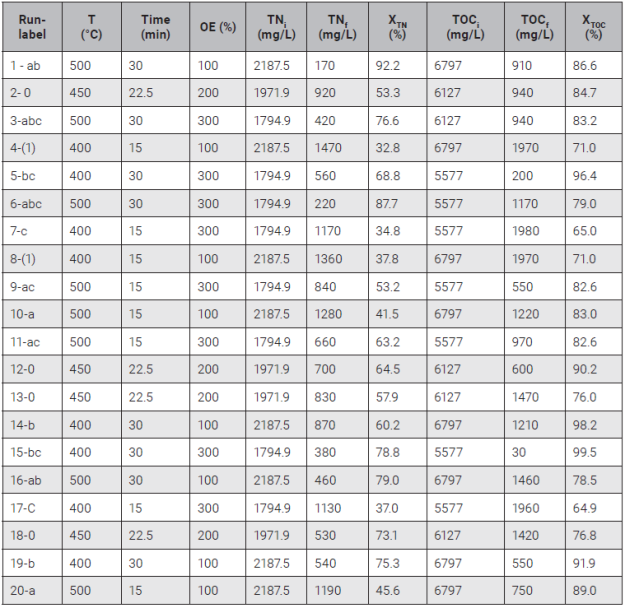
Source: The authors.
2.1 Total organic carbon ANOVA
According to the TOC normal plot of standardized effects shown in Fig. 2, factor B (Reaction time) and the interaction AB (Temperature and reaction time) have a significant effect on the response. However, factor A (Temperature) and factor C (oxygen excess) did not have a significant effect. Temperature and oxygen have a positive effect on oxidation reactions rates, and SCWO studies are usually carried out in a continuous manner with a few seconds of residence time at temperatures higher than 500°C and oxygen excess over 300 % 15, 20. The lack of a positive effect in both factors could be attributed to the prolonged reaction time considered in this study, which was long enough, even in the level low, for the oxidation reaction to proceed almost to completion. On the other hand, as expected in any reaction, the interaction between temperature and time means working at higher temperature results in a shorter reaction time. The nature of the interaction for this study is discussed next.
The model had a regression coefficient R2= 88.39 %. Since A, C, BC, AC and ABC terms are insignificant; the design was re-analyzed dropping these terms from the model. The normal probability plot of the residuals and residuals versus, fitted values or constant variance plot for the re-analyzed design are shown in Figs. 3 and 4.
As can be observed in Fig. 3, the normal probability plot of the residuals resembles a straight line; therefore the error distribution is normal. In a similar way, Fig. 4 shows a random patter of the residuals on both sides of 0, without any recognizable patterns. Therefore, the model is correct and the assumptions were satisfied. ANOVA for the re-analyzed model is summarized in Table 2 and resulting model is given in Equation (6).
Table 2 ANOVA for TOC destruction efficiency.
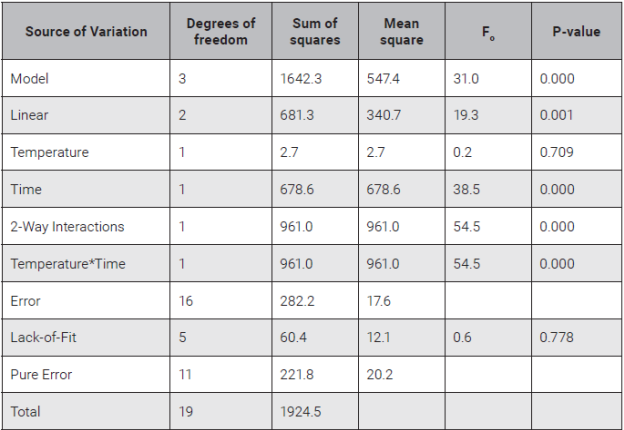
Source: The authors.
TOC = -150.0 + 0.4733*Temperature + 10.17*Time - 0.02067*Temperature*Time (6)
The standard deviation was 4.19959. According to the P-values in the ANOVA for TOC destruction efficiency in Table 2, the model has a P-value of 0.000, whereas lack of fit was not significant, which means the model fits well the data. In a similar way, the main effects of reaction time (B) and the interaction AB of temperature and reaction time are highly significant, with P-values < 0.01.
According to Montgomery 29, the main effects do not have much meaning when there are involved significant interactions. While the positive effect estimated for B factor suggest working at the high level of the reaction time to increase the TOC destruction efficiency, AB interaction might indicate the opposite trend. AB interaction plot is shown in Fig. 5.
Fig. 5 shows that the effect of time is significant when working at 400°C and negligible when working at 500°C. The higher reaction temperature speeds up the reaction and as a result, the TOC mean destruction efficiencies are similar at 15 and 30 minutes, as was previously discussed. However, TOC mean destruction efficiencies are higher when working at 400°C and 30 min reaction time. Usually, SCWO experimental studies report a positive effect of temperature when working in a continuous unit set up and with residence times of a few seconds 15, 30. The heating time of the substance to oxidize and the oxidant agent pumped separately, is not accounted for as part of the total reaction time and could be even longer than the residence time in the reactor. From Fig. 5 it can be concluded that the optimal operation conditions for TOC destruction are 400 °C, 30 min reaction time and 100 % oxygen excess since this factor was not significant. However, factors effect on TN destruction could be different and suggest a different set of operation conditions. TN ANOVA is discussed next.
2.2 Total nitrogen ANOVA
ANOVA for TN destruction efficiency is shown in Table 3, and TN normal plot of standardized effects is presented in Fig. 6. Data standard deviation was 7.18584. The model in Equation (7) had a P-value of 0.000, and an R2 value of 90.23 %, lack of fit was not significant, which means the model fits well the data. Main factors A and B, temperature and time, have a significant effect on nitrogen abatement, with P-values for temperature and time of 0.001 and 0.000, respectively. Oxidant excess did not have a positive effect, which can be attributed again to the prolonged reaction time. Differently, from what was observed for TOC destruction, there are no significant interactions for TN. Accordingly, the design was re-analyzed dropping the terms C, AC, BC, AB and ABC from the analysis. The results are shown in Figs. 7 and 8. Normal probability plot resembles a straight line, and residuals show a random pattern around 0; therefore, there is no reason to suspect any problems with the validity of the conclusion. TN temperature and time main effects plot is shown in Fig. 9.
Table 3 ANOVA for TN destruction efficiency
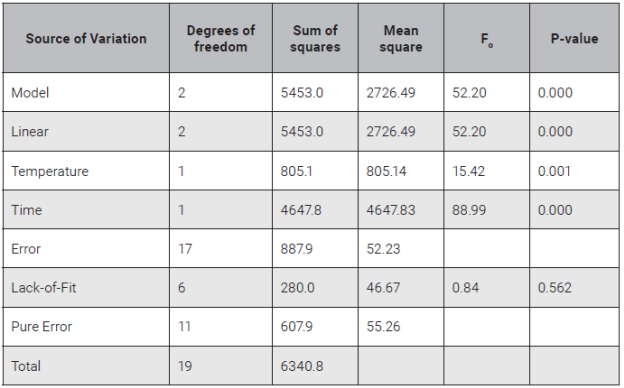
Source: The authors.
TN = -54.3 + 0.1419*Temperature + 2.272*Time (7)
Fig. 9 shows the positive effects of temperature and time, which suggest the optimal operation conditions for achieving a high TN destruction efficiency are 500 °C, 30 min reaction time and 100% oxygen excess. Although temperature effect was found insignificant for TOC destruction when working at residence times longer than 15 min, ammonia-nitrogen (NH3-N), formed as a stable intermediate compound in the oxidation of nitrogen-containing components, is a well-known recalcitrant compound and usually requires temperatures higher than 600 °C in the SCWO process 6, 31-33. In fact, it has been suggested the ammonia oxidation to nitrogen or nitrous oxide is the rate limiting step in the global oxidation 7. At 400°C, 30 min and OE of 100%, optimal operation conditions for TOC destruction, average TN destruction of runs 14 and 19 is 68 %, which might be insufficient to meet the most stringent TN discharge limits. However, this result is much better than the 46.9 % ammonia conversion reported by Wang et al,23 in the SCWO of leachate at 400°C, OE of 350 % and 300 s reaction time, with a heating velocity of 4.07 °C/min in the absence of the oxidant.
The difference could be attributed to the experimental procedure followed in this work, in which the leachate and oxidant were mixed and heated up to reaction conditions and left for a particular time. In this aspect, hydrogen peroxide rapidly decomposes with temperature, producing reactive OH free radicals 26, which could promote fast organic matter oxidation reactions. Heating up separately could cause pyrolysis of the organic compounds 34, 35 as well as the thorough decomposition of peroxide to oxygen, which is a less reactive oxidant agent. Temperature-time contour plots for TOC and TN destruction efficiencies, generated by the statistical software Minitab from data quadratic regression models in the studied experimental region, are shown in Fig. 10. As it was shown in TOC ANOVA, the temperature-time significant interaction causes the TOC destruction efficiency contour plots to curve when temperature goes from low (400°C) to high (500°C), whereas TN contour plots are straight due to the absence of significant interactions and TN destruction efficiency increases with the temperature and time. Although high TN destruction efficiency can be obtained at 500°C, as shown in TN contour plots and also suggested by other works 23, Fig. 9 indicates that a reaction time longer than 30 min could increase TN destruction efficiency. Therefore, not only high TOC but also TN destruction efficiency could be obtained working at 400°C, OE of 100 % and reaction times longer than 30 minutes. From a scale-up point of view, a reaction temperature of 400°C is more desirable than 500°C due to increased cost of equipment construction materials and also the higher energy consumption expected when working at 500°C. Even though the results were obtained in a batch reactor, the implemented experimental procedure of mixing the leachate and oxidant and heating up to reaction conditions would be similar to the operation of a continuous unit in which the leachate-oxidant mixture is pumped through preheaters up to the reaction temperature and kept constant for a residence time similar to those found in this study.
3. Conclusions
This work reports the SCWO of landfill leachate in a batch reactor system in which the joint effect of temperature, time and oxygen excess were assessed using a factorial experimental design. ANOVA for TOC and TN destruction efficiency showed the temperature-time interaction was significant for TOC destruction efficiency and the interaction plot showed the optimal operation conditions for TOC destruction were 400°C, 30 min and 100 % OE. Temperature and time factors were significant for TN destruction efficiency, which were higher than those reported by other works at similar reaction conditions: main effect plots showed the optimal operation conditions were 500°C, 30 min and 100% OE. Although the higher temperature is required for TN destruction, contour plots showed an even longer reaction time could increase TN destruction efficiencies while keeping the reaction temperature at 400°C, a more desirable reaction temperature from a scale-up point of view.
Finally, it is important to strengthen the development of this type of research, mainly because in the past some knowledge limitations have been found and one of the biggest gaps is the easy way methodology to carry out a risk assessment, specifically for landfill leachate 36. Likewise in different countries, there is some evidence that shows the research on sources contaminated with leachate was useful for enforcing the environmental regulations and improving the environmental quality 37.






















